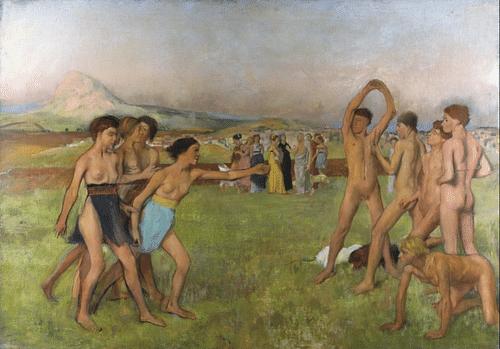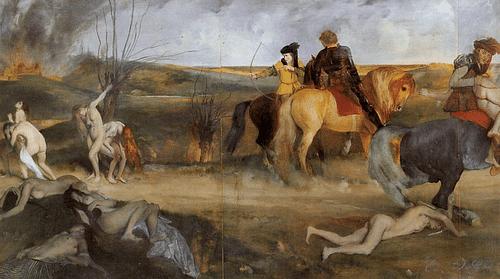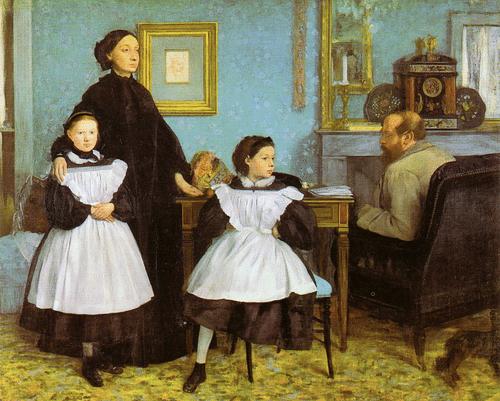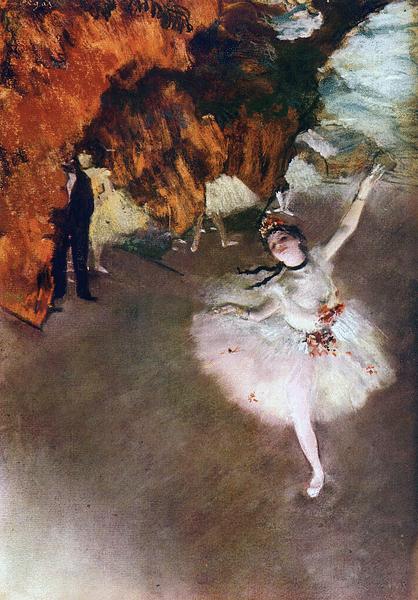Edgar Degas (1834-1917) was a French impressionist painter who used many different media to capture dancers, bathers, horse races, and scenes from Parisian café society. A keen photographer, Degas' paintings frequently show real-life captured in a moment in time, often with an unusual viewpoint, composition or framing – all of which techniques would prove influential on later artists.
Early Career
Hilaire-Germain-Edgar De Gas (better known simply as Edgar Degas) was born on 19 July 1834 in Paris. His parents were wealthy bourgeois who specialized in banking. Edgar's father, Auguste, was half Italian and half French while his mother, Célestine Musson, was an American Creole of French descent from Louisiana. Young Edgar studied at Paris' Lycée Louis-le-Grand, earning his baccalaureate in literature. In a family already rich enough but with aspirations to climb even higher socially, Edgar was encouraged to become the accomplished and fashionable young male of the period and to formally study art and music under various tutors. He also began to study law, but it soon became clear that art was his true path.
In 1855, Degas enrolled in the École des Beaux-Arts in Paris. He studied and copied the Old Masters in the Louvre, and in July 1856, he went to see firsthand the Renaissance art of Italy on a tour which took in Florence, Rome, Naples, and Venice. He sketched the art of antiquity, Renaissance works, local colour, and he produced his first great painting, The Bellelli Family, while staying with his aunt Laura Bellelli in Florence in 1858.
Back in Paris, Edgar was tutored by Louis Lamothe (1822-1869) and then Nicolas Soutzo (1834-1907). This traditional artistic education led the young Degas to try and become a historical painter, that is an artist who depicts grand religious or historical scenes like the great Renaissance artists had produced. Examples of his work in this genre, which share a frieze-like presentation of the subject, include Young Spartans Exercising and Semiramis Building Babylon, both painted around 1861. Not untypically, Degas continued to work on the Young Spartans in subsequent years.

Portraits were another avenue he explored, and here the artist had more success in achieving his aims. Interested in giving his work a psychological element and depth, Degas often painted double portraits where the attitudes and emotions are shown markedly different between the two people in the painting. A recurring feature of Degas' portraits is the use of a painting within the painting. Like Renaissance artists who used objects as symbols that might convey more depth of meaning to a knowing viewer, Degas often included a notable painting that comments on the personality of the person being portrayed. However, it was another historical epic, Medieval War Scene that first got him noticed by the jury of the Paris Salon in 1865.
Eventually dissatisfied with the limitations of being too tied to the past or perhaps sensitive to the changes in contemporary art, Degas would turn instead to capturing everyday life as it happened in the circles he was most familiar with: bourgeoise Paris. His first work which shows this transition, and yet in which he still maintains a link to the historical painting style, is Mademoiselle Fiocre in the Ballet 'La Source'. The work was exhibited in the Paris Salon of 1868. The artist was about to fully move into modernity for his subjects, but Degas' long immersion in classical art and the more recent Neoclassicist artists like Jean-Auguste-Dominique Ingres (1780-1867) would have a lasting effect on the importance he gave to drawing, form, and composition, as well as the prominence he gave to the female nude. As Ingres had told Degas: "Draw lines, young man, many lines" (Howard, 42). This focus meant that Degas was probably the superior draughtsman of all the impressionist painters of his generation, a point noted by many critics.

The Temperamental Artist
Degas had a complex character; even his artist friends seem to have sometimes found him exasperating, particularly as his famed wit could both charm and cut. The art historian V. Bouruet Aubertot gives the following summary of Degas' character:
Gruff yet sensitive, arrogant and discerning, intransigent and restless, Edgar Degas was a man of paradoxes…He maintained loyal friendships and kept himself fiercely independent from official circles and fashionable fads.
(312)
Degas was fortunate in that his family's wealth meant that, for most of his career, he did not have to earn a living from his art. In terms of sales to the public, Degas first made a name for himself as a portrait painter, and his realist style won acclaim from the critics. Unlike many of the other impressionists, he built up a loyal group of patrons who bought his work. He also bought art himself, notably 19th-century painters and other impressionists, and he collected Neapolitan puppets.
Edgar Degas: A Gallery of 30 Paintings
Fellow Impressionists
In the 1860s, a group of young avant-garde artists hung about together in the cafés of Paris. They passionately discussed what should be the new direction of art, especially the Café Guerbois and others in the Batignolles area of Paris. This group included such future household names as Paul Cézanne (1839-1906), Pierre-Auguste Renoir (1841-1919), Claude Monet (1840-1926), and Edouard Manet (1832-1883). They were also joined by literary men like Émile Zola (1840-1902). Degas was a member of this group, which became known as 'the Batignolles.' He was sometimes a little isolated from the group, more by his own attitude than anything else, and he did not always get on with Manet, the de facto leader, even if the two were the closest artistically. Manet did not like Degas' widening of the group to include new blood and artists more interested in realism than impressionism.

Degas was particularly close to the two prominent female artists: Mary Cassatt (1844-1926) and Berthe Morisot (1841-1895), both of whom he introduced to the impressionist group. The latter once described Degas in a letter as "always the same, a bit mad, but charming in spirit" (Bouruet Aubertot, 314). Degas never married and kept his private life private so that the only glimpse we have into it are a few guarded comments from those few friends who got close enough to the artist to be invited to his studios in Montmartre. As Degas had once said, "The artist must live apart, his private life should be unknown" (Roe, 35).
The artist group broke up in July 1870 with the outbreak of the Franco-Prussian War. Degas joined the National Guard as a volunteer to defend Paris during the siege of the capital; Manet did the same. Degas continued to make sketches of his colleagues in the French artillery. A civil war then followed that continued to interrupt everybody's careers. It was a good time to get away from the turmoil, and in 1872, Degas went to the United States, sailing to New Orleans to see family on his mother's side. There he created a modern masterpiece, his 1873 The Cotton Market, New Orleans. The scene is an office bustling with 13 people, including buyers, brokers and office layabouts, all revolving around a long central table layered with cotton.

Back in Paris in peacetime, in April 1874, the impressionists organised their own independent showing to challenge the monopoly of the Paris Salon. This was the First Impressionist Exhibition, and Degas was represented with ten paintings, pastel drawings, and sketches. He appeared again in the next five impressionist exhibitions (1876-81) and was often one of the better-received artists by the ultra-conservative critics.
Degas' Style & Interests
Degas painted on many diverse subjects, but some themes appear again and again in his work. He was particularly interested in horses and so spent a good deal of time studying them at the fashionable racecourses of Paris. The colour of the circus, the bustle of café society, and the solemnity of the stock exchange also caught his eye. One subject above all seems to have enthralled the artist, and that was the world of theatre, particularly opera and ballet. Another common theme that interested the artist is the behind-the-scenes view of public performance: Degas was very fond of showing horses between races and ballerinas at their rehearsals.
The 1860s was the golden age of horse racing, and Degas' interest in realistically capturing thoroughbred horses can be traced back through his sketches to the very early years of his career. Another feature of the sport that greatly interested him was the tension just before a race began or after a false start. Many of his paintings still show the frieze-like quality we noted earlier, but now he has added the influence of Japanese prints (very popular at the time in France). The scenes have unusual cut-off points, asymmetry, and perspective; they are deliberately quirky so that the balance of the picture is out of tilt as if he had taken a photograph a second too early or a little too late. The effect is to give the painting a new realism, literally a snapshot in paint as opposed to a formal and posed studio photograph. An excellent example of this technique is Jockeys before the Race (c. 1878-9).

Degas is nowadays most famous for his many depictions of ballerinas. Asked by a friend why he found the subject so intriguing, Degas replied "Because…it is all that is left to us of the combined movements of the Greeks" (Kear, 46). By 1878, when the Degas family went bankrupt, there may, too, have been added a more practical reason for painting ballerinas. Edgar was not a great saver, despite his success, and his love of collecting art meant that he now struggled for funds. Ballerinas were a subject he could sell to art connoisseurs. His most famous painting on this theme is the 1876 The Star, where a single dancer is seen from above as if from one of the expensive boxes. As with the horse races, the ballerinas are often shown in preparation or taking the applause of the audience but not actually performing. Painting ballerinas, Degas becomes his most impressionistic, capturing the strange artificial light thrown by stage lights on the performers. The behind-the-scenes of the dancers often reveal the physical strains and mental trials of endless rehearsals for those dancers who wanted to reach the top of their profession.
The contrasting roles of men and women is a running theme throughout Degas' career. This can be seen in double portraits, a male audience watching dancers, or a male instructor in a ballerina class. The ultimate expression of this interest can be seen in Interior, a work the artist always kept for himself to show visitors. Painted c. 1868 but receiving later adjustments, the scene of Interior presents an unknown relationship between a man and a woman in a bedroom. In the strictest sense, then, this is not a genre painting where a narrative is clearly explained to the viewer (even if left a little ambiguous). Nevertheless, Degas himself often referred to it as "my genre picture" (Kear, 40). The artist never told his visitors what the scene meant, for, as he once stated, "a painting calls for a certain mystery, some vagueness, some fantasy" (Kear, 41)

Although very much part of the impressionist group, Degas was a slightly different sort of painter – indeed, he preferred to label the group of avant-garde artists as "independent painters" since no one style suited them all. Degas preferred the traditional method of sketching a scene and painting it in the comfort of the studio than the typical impressionist approach of painting in the open air (en plein air). As he once stated, "you need natural light, but I need an artificial one" (Bouruet Aubertot, 313). Degas frequently traced drawings of figures and put various combinations together to create a new composition. Consequently, it is sometimes possible to see the pose of a ballerina in one of his works showing bathers. Degas continued to be, like the Old Masters, a staunch defender of the need for good lines and drawing. Degas' impressionism focussed not on capturing the temporary play of light on colours but on capturing a person or scene in a novel way. In short, he, like several others in the group, saw the limitations of a purely impressionist approach, especially on subjects where closer proximity to reality was required.
Degas was very interested in photography and was one of the few to see that this was, in fact, a whole new art form in itself. He took photos himself, and from the photographer's repertoire, Degas applied ideas like novel framing, not having the subject dead-centre, and giving an elevated perspective. In this way, the painter gave his work a sense of movement and realism.

Degas also liked to try different media. Besides oil paints, he frequently used gouache, that is, diluted oils that made the work look more like a watercolour. He often used pastels, and for a period, he studied in-depth the art of engraving and monotype printing. Often he combined monotype and pastel work in the same picture. He sculpted, too, particularly towards the end of his career when his sight was failing, mostly using wax, clay, and plaster to capture poses of the human body. One of his most celebrated sculptures is La Petite Danseuse de Quatorze Ans (Little Dancer Aged Fourteen), created around 1878.
Later Career
Degas was represented in the impressionist show in the Hôtel du Grand Miroir in Brussels in 1885. It was from this time that the artist entered a new phase where he concentrated less on scenes of daily life in Paris and much more on aesthetic form in his work and capturing the form of the human body, typically as seen in dancers and bathers. A celebrated work of this new phase is The Tub of 1886, which shows a woman bathing herself from an unusual elevated viewpoint and with the scene vertically cut by a shelf. This painting, and other works like it, is striking for the lack of distance Degas provides between the viewer and the subject.
Many of these later female studies give no individual character to the woman portrayed, and this did add fuel to Degas' already smouldering reputation as a misogynist. Others see this anonymity – we hardly ever see the face at all – as a method of removing any sensual desire and so the viewer, still left as a voyeur, is now only an admirer of the universal female form busy with a functional daily task. The woman that is the focus of these works is completely unaware she is not alone; we know that she is an artists' model, and yet she is not doing what artists' models usually do. Like with the races and the ballerinas, we are given a glimpse of behind-the-scenes life.

In 1889 the artist travelled to Spain and Morocco. In 1892 he visited Switzerland and the southwest of France. In that year, he organised a new exhibition in Paris, surprising everyone with his return to landscapes. These works have several similarities: they use pastels, no people are shown, they are created in the studio, and they have a slightly fuzzy appearance (leading to one critic likening them to views from a fast train). They seem to be an exercise in presenting harmonious tones of colour, and so the physical landscape seems largely immaterial.
In 1896 Degas exhibited his photographs, and he continued with his pastel works and sculpture, but his failing sight meant his output and number of public appearances declined. Into the 20th century, the artist was living a retired life, but his reputation was growing steadily in the outside world. In 1911 the Louvre acquired 19 of Degas' works, an honour usually only given after an artist had died; perhaps creatively, Degas already had.
Death & Legacy
Edgar Degas, at the age of 83, died on 27 September 1917 in his apartment in Paris. He was buried in the cemetery of Montmartre. He had never married or had children, as he himself had once said: "There is love and there is art and we only have one heart" (Kear, 66). Degas had enjoyed a long career and earned more recognition than most other artists of his generation. Camille Pissarro had once written in a letter: "Degas is without doubt at all the greatest artist of our time" (Kear, 86). He was greatly admired, too, by the next generation of artists, notably Henri de Toulouse-Lautrec (1864-1901). Degas' knowledge of art history, mastery of draughtsmanship, innovations, and championing of everyday life were all essential ingredients in what had become known as modern art. The unusual viewpoints, odd effects of lighting, and psychological tension that pervade Degas' works have ensured they continue to fascinate and inspire today just as they did over a century ago.
